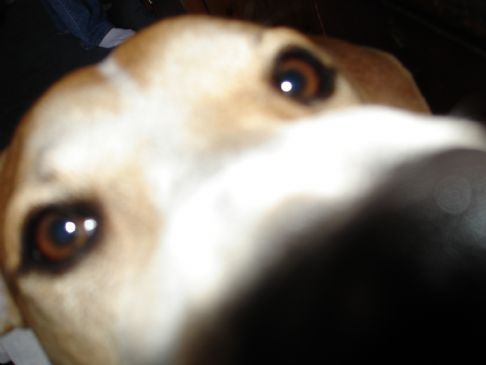When we moved in to our house, as I was reveling at the glory of a whole laundry
room (as opposed to the laundry closet we used to have), I noticed that our washing machine had been rigged in some way. Usually, if you open a washing machine during the spin cycle, it will stop spinning. This is because it would be dangerous to reach in there , and people are dumb. I didn't think much of it at the time.
Then, I decided to wash a blanket. The machine stopped right before the spin cycle. I went down and saw my blanket sitting in a lot of water, and soapy. I tried just starting the machine over again, and the same thing happened. So I tried it again.
Because I'm brilliant.
I figured I had broken the machine because our addition was finished, and the bathroom was finished, and we were thinking about maybe, someday, having some spare cash to buy a couch, so it would make sense that now I would do something stupid and break the machine and cost us basically another grand.
Because being a home owner has taught me to be an optimist.
Thankfully, I was wrong. The rigging for the lid switch had broken. This is what had been making my washing machine work:
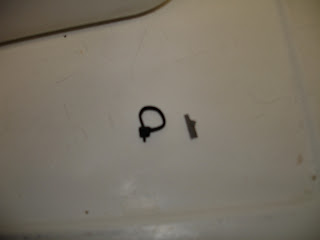
A lid switch basically functions like this: There is a little tab on the washer lid that fits into a hole on the machine. When you close the lid, the tab hits a lever, which closes the circuit to the wiring in the machine, that tells it that it is
ok to spin.
Of course, I did not know that it was a lid switch problem, or what a lid switch was, until I did some searching on the
internet. The
internet told me that it would cost about $15 to replace the part and that I (yes! Me!) could fix it myself. Getting a guy out to replace the $15 part would cost about $100 plus parts plus labor. That's more plus than I'm looking for, so I found directions for taking the washing machine apart and got to work fixing it my damn self.
First, obviously, I had to get a new lid switch. Thankfully, Sears Service Centers are conveniently located near you (or my husband's office). They had one lid switch for our model washing machine. It's more like $25, but still
ok with me. Of course, Mr kept forgetting to go pick it up, so it was a week later (and now a desperate laundry situation) that I finally went my damn self.
Naturally, being a week later, they do not have the part. But lo! A new Sears has opened a mere two minutes from my house (as opposed to the 30 it took to drive to the first one) and it seems they have it in stock. I drove over there, and, naturally, they do not have it in stock. A snotty saleswoman informs me that they just recently moved to that location, so their inventory is "all messed up." She offers to order it for me, but I won't get it for three years. I decline, and order it myself at home, because Sears will feel my wrath and lose my $25 sale.
However, now we need clothes. I can't even just buy new ones because I prefer to wash my clothes before I wear them. So I soldier on, determined to fix it temporarily until I get the part.
First step: pry off the side caps. They look like they're permanent, and it feels like you're breaking your washing machine, but you aren't. Just get a screw driver (preferably a flat head) and wedge it under one of the corners of the end caps and pop it off.


Take off both end caps and unscrew the screws that they were hiding. Then, you just have to flip that control panel part up. Only it isn't just an easy flip. The next picture is a bit fuzzy. It is also on its side. The left-hand side is actually the top. See the little white thingy poking out of the black metal part? That is basically a hinge. Once you pop the end caps off, you have to work the whole control panel up until the white
thingies on both sides move up that groove and into the top part, where they will have room to move.
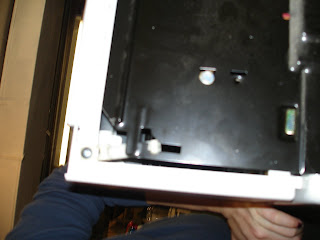 Then
Then it will just flip up:

Pretty cool, right?
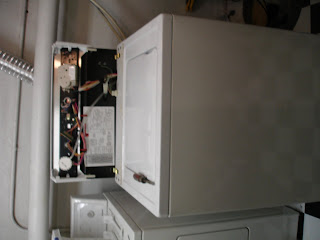 Ok
Ok, next, you pop out those gold
doo-dads, which connect the cover to the back and base. Again, just use the screw driver to pry them out. This takes a little bit of muscle, but isn't as nerve-wracking because those gold
doo-dads clearly work on tension, so you don't have to worry about breaking them. They tend to really pop out though, so make sure you don't lose them when they go flying.


(Look how gross it gets under the console. Who knew?) The next part is a little scary, but also fun. If you go up to the picture with the control panel flipped back, you'll see a bundle of wires leading to a clear-
ish white tab heading into the cover. You have to disconnect them by taking the screw driver again and prying the tab on the big tab up.
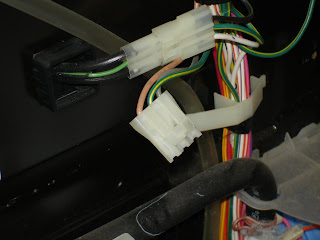
Then, you walk the cover off of your washing machine. Once the cover is no longer secured to the back, washing machines are really, really flimsy. In reality, a washing machine is a big barrel with a thin metal box around it. Without some
reinforcements, they wiggle a lot.

To replace the lid switch, you have to basically get inside the washing machine cover.
In the next picture, you can see the switch. It's the gray plastic thingy. See the little white plastic post? That is supposed to be pushing down a little lever, which broke off, which is when the previous owners used a zip tie to hold down the broken tab, which eventually broke off.

It is connected by the screw on the right-hand side, which is also grounding the wires. Everything else is in clips that you can just pull out. It's surprisingly simple. If your machine is broken, I highly recommend the site I linked to above - they have pretty good instructions. Plus, it never occurred to me to take a picture of the new switch. Oops. Anyway, since I didn't have a new switch when I did the first fix, this is how I solved the problem:
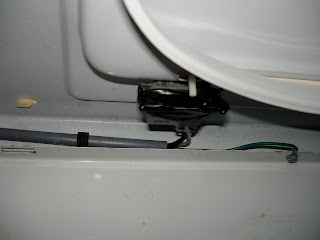
Electrical tape is good, because it is stretchy, so you can really get a tight fit. Sadly, this worked for only a short time, but long enough to get a few loads of laundry done and carry us through until the replacement switch arrived.
Check it out:
